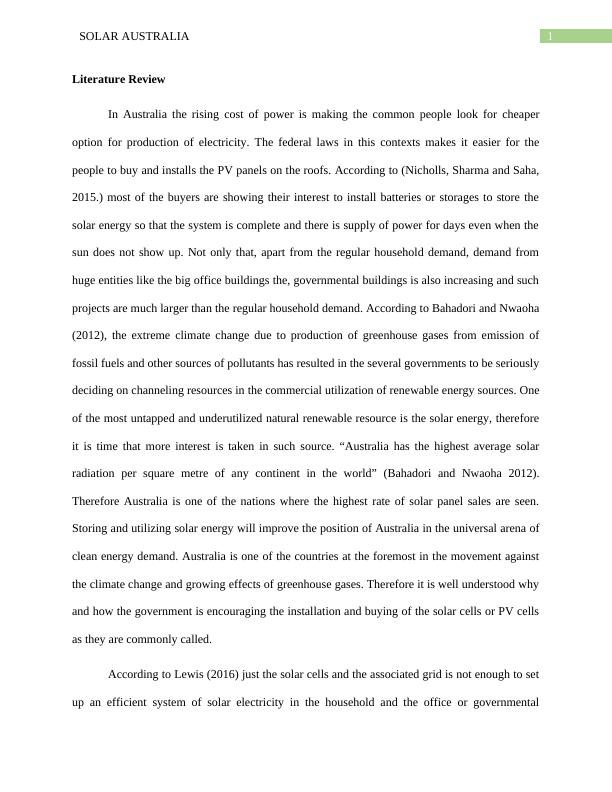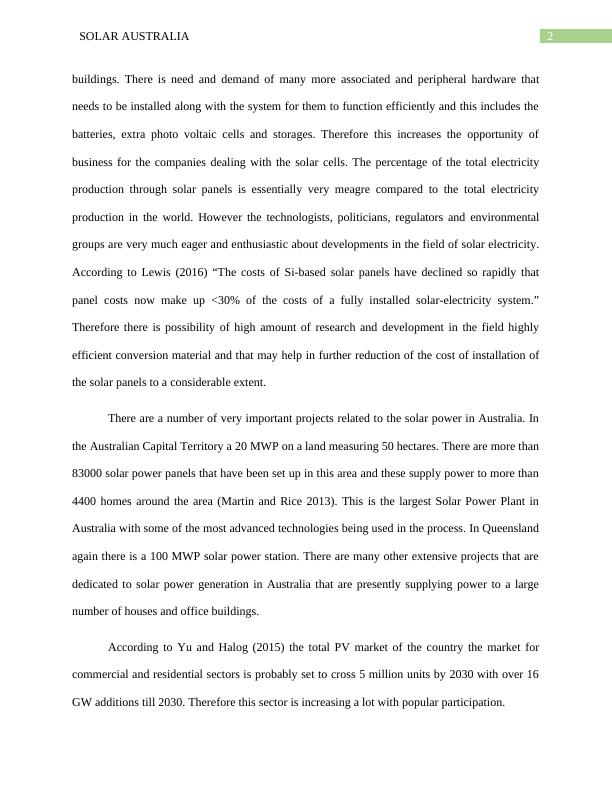Solar Energy Utilization in Australia: A Review
Added on 2023-06-05
6 Pages1421 Words189 Views
Running head: SOLAR AUSTRALIA
SOLAR AUSTRALIA
Name of Student
Name of the University
Author note:
SOLAR AUSTRALIA
Name of Student
Name of the University
Author note:

1SOLAR AUSTRALIA
Literature Review
In Australia the rising cost of power is making the common people look for cheaper
option for production of electricity. The federal laws in this contexts makes it easier for the
people to buy and installs the PV panels on the roofs. According to (Nicholls, Sharma and Saha,
2015.) most of the buyers are showing their interest to install batteries or storages to store the
solar energy so that the system is complete and there is supply of power for days even when the
sun does not show up. Not only that, apart from the regular household demand, demand from
huge entities like the big office buildings the, governmental buildings is also increasing and such
projects are much larger than the regular household demand. According to Bahadori and Nwaoha
(2012), the extreme climate change due to production of greenhouse gases from emission of
fossil fuels and other sources of pollutants has resulted in the several governments to be seriously
deciding on channeling resources in the commercial utilization of renewable energy sources. One
of the most untapped and underutilized natural renewable resource is the solar energy, therefore
it is time that more interest is taken in such source. “Australia has the highest average solar
radiation per square metre of any continent in the world” (Bahadori and Nwaoha 2012).
Therefore Australia is one of the nations where the highest rate of solar panel sales are seen.
Storing and utilizing solar energy will improve the position of Australia in the universal arena of
clean energy demand. Australia is one of the countries at the foremost in the movement against
the climate change and growing effects of greenhouse gases. Therefore it is well understood why
and how the government is encouraging the installation and buying of the solar cells or PV cells
as they are commonly called.
According to Lewis (2016) just the solar cells and the associated grid is not enough to set
up an efficient system of solar electricity in the household and the office or governmental
Literature Review
In Australia the rising cost of power is making the common people look for cheaper
option for production of electricity. The federal laws in this contexts makes it easier for the
people to buy and installs the PV panels on the roofs. According to (Nicholls, Sharma and Saha,
2015.) most of the buyers are showing their interest to install batteries or storages to store the
solar energy so that the system is complete and there is supply of power for days even when the
sun does not show up. Not only that, apart from the regular household demand, demand from
huge entities like the big office buildings the, governmental buildings is also increasing and such
projects are much larger than the regular household demand. According to Bahadori and Nwaoha
(2012), the extreme climate change due to production of greenhouse gases from emission of
fossil fuels and other sources of pollutants has resulted in the several governments to be seriously
deciding on channeling resources in the commercial utilization of renewable energy sources. One
of the most untapped and underutilized natural renewable resource is the solar energy, therefore
it is time that more interest is taken in such source. “Australia has the highest average solar
radiation per square metre of any continent in the world” (Bahadori and Nwaoha 2012).
Therefore Australia is one of the nations where the highest rate of solar panel sales are seen.
Storing and utilizing solar energy will improve the position of Australia in the universal arena of
clean energy demand. Australia is one of the countries at the foremost in the movement against
the climate change and growing effects of greenhouse gases. Therefore it is well understood why
and how the government is encouraging the installation and buying of the solar cells or PV cells
as they are commonly called.
According to Lewis (2016) just the solar cells and the associated grid is not enough to set
up an efficient system of solar electricity in the household and the office or governmental

2SOLAR AUSTRALIA
buildings. There is need and demand of many more associated and peripheral hardware that
needs to be installed along with the system for them to function efficiently and this includes the
batteries, extra photo voltaic cells and storages. Therefore this increases the opportunity of
business for the companies dealing with the solar cells. The percentage of the total electricity
production through solar panels is essentially very meagre compared to the total electricity
production in the world. However the technologists, politicians, regulators and environmental
groups are very much eager and enthusiastic about developments in the field of solar electricity.
According to Lewis (2016) “The costs of Si-based solar panels have declined so rapidly that
panel costs now make up <30% of the costs of a fully installed solar-electricity system.”
Therefore there is possibility of high amount of research and development in the field highly
efficient conversion material and that may help in further reduction of the cost of installation of
the solar panels to a considerable extent.
There are a number of very important projects related to the solar power in Australia. In
the Australian Capital Territory a 20 MWP on a land measuring 50 hectares. There are more than
83000 solar power panels that have been set up in this area and these supply power to more than
4400 homes around the area (Martin and Rice 2013). This is the largest Solar Power Plant in
Australia with some of the most advanced technologies being used in the process. In Queensland
again there is a 100 MWP solar power station. There are many other extensive projects that are
dedicated to solar power generation in Australia that are presently supplying power to a large
number of houses and office buildings.
According to Yu and Halog (2015) the total PV market of the country the market for
commercial and residential sectors is probably set to cross 5 million units by 2030 with over 16
GW additions till 2030. Therefore this sector is increasing a lot with popular participation.
buildings. There is need and demand of many more associated and peripheral hardware that
needs to be installed along with the system for them to function efficiently and this includes the
batteries, extra photo voltaic cells and storages. Therefore this increases the opportunity of
business for the companies dealing with the solar cells. The percentage of the total electricity
production through solar panels is essentially very meagre compared to the total electricity
production in the world. However the technologists, politicians, regulators and environmental
groups are very much eager and enthusiastic about developments in the field of solar electricity.
According to Lewis (2016) “The costs of Si-based solar panels have declined so rapidly that
panel costs now make up <30% of the costs of a fully installed solar-electricity system.”
Therefore there is possibility of high amount of research and development in the field highly
efficient conversion material and that may help in further reduction of the cost of installation of
the solar panels to a considerable extent.
There are a number of very important projects related to the solar power in Australia. In
the Australian Capital Territory a 20 MWP on a land measuring 50 hectares. There are more than
83000 solar power panels that have been set up in this area and these supply power to more than
4400 homes around the area (Martin and Rice 2013). This is the largest Solar Power Plant in
Australia with some of the most advanced technologies being used in the process. In Queensland
again there is a 100 MWP solar power station. There are many other extensive projects that are
dedicated to solar power generation in Australia that are presently supplying power to a large
number of houses and office buildings.
According to Yu and Halog (2015) the total PV market of the country the market for
commercial and residential sectors is probably set to cross 5 million units by 2030 with over 16
GW additions till 2030. Therefore this sector is increasing a lot with popular participation.

End of preview
Want to access all the pages? Upload your documents or become a member.
Related Documents
Solar Australia: A Green Energy Initiativelg...
|12
|1058
|62
Solar Energy PV Panel in Construction PDFlg...
|9
|2478
|84
Marketing Principle of Solar Industry in Australialg...
|10
|2196
|124
(PDF) Solar Energy and Photovoltaic Systemslg...
|44
|10933
|150
Combined Solar Energy Systemlg...
|17
|3612
|12
South Australian Renewable Electricity Supplylg...
|8
|2053
|46
